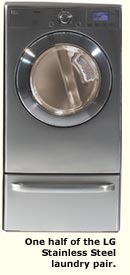Energy Efficiency: Modern Dream, Green Machine - Page 5
Rather than holding water in a tank, tankless heaters circulate it through a series of burners or electric coils that heat the water as it passes through. Though they often cost more than most conventional water heaters, tankless models are cheaper to operate because energy isn't required to maintain a large tank of hot water 24 hours a day.
A big bonus: they rarely run out of hot water—unless, of course, the flow surpasses the unit's ability to heat it. This can happen if a household has two showers running or multiple hot-water appliances functioning at the same time. Many whole-house tankless heaters are gas-fired and require some venting that's larger than conventional gas water heaters. Like conventional water heaters, however, some units have power vents that allow you to exhaust gasses out a sidewall.
LaChance points out that newer tankless models have many safety features. When new units are installed, almost everything gets replaced—the pump, vent pipe, copper, electronic components, and fittings. Homeowners can also consider a combination boiler and water heater unit that puts heated water and household heat into one appliance.
13. Go 'low flow' in the bathroom
Low-water consumption toilet. The bathroom is one of the busiest rooms in the home, and toilets are some of the greatest water users. When it's time to remodel, consider using water-conserving bathroom fixtures to reduce the amount of water usage. Low-water consumption toilets are great for homeowners seeking the benefits of water conservation, and many of these toilets also qualify for water rebate programs.
Residential 1.6-gallon toilets have been shown to reduce toilet water use by 23 to 46 percent in studies conducted in a number of major cities. A study published in 1999 by the American Water Works Association Research Foundation that looked in detail at the water use in nearly 100 homes in each of 12 North American cities concluded that high-efficiency toilets save an average of 10.5 gallons per person daily. Nationally, the use of high-efficiency toilets through new construction and normal replacements is estimated to save in excess of 7.6 billion gallons per day by 2020.
If you're looking for an option, the Highline Pressure Lite toilet ($508) by Kohler has a low 1.1-gallon flush setting that reduces water consumption by more than 30 percent, or more than 5,000 gallons of water per toilet, per year.
14. Cleaner clothes, less water

Laundry appliance upgrade. Make a dent in your water and electric bill with new energy-saving washer and dryers. Manufacturers say that front-load washing machines save the average family $90 per year and use half of the water needed in conventional top-loaded models—that's a savings of 9,000 gallons of water. Major appliance makers, like Maytag, Amana, Kenmore, LG, Miele, and Samsung, all offer horizontal-axis washing machines that not only help conserve water, but also clean clothes better because items aren't sloshing around in a tub of dirty water. Europeans have been using these models for years.
Introduced this year, the LG Stainless Steel Steam Laundry Pair not only helps conserve water and energy, it also uses steam to deep-clean clothes and reduce wrinkles. For the tech-obsessed, this duo also has an optional remote monitoring system that will let you keep track of a laundry cycle's progress without repeated trips to the laundry room.
The washer and dryer each retail for a hefty $3,499. For a more conservatively priced option, consider the front-loading Maytag Neptune washer for $699.
15. Storehouse for 'lost' power
Power-Save 1200 Unit. Another way to conserve energy and money is by reducing the amount of electricity your appliances draw from public utilities. Power-Save Energy Corp. has marketed a new energy-savings device, the Power-Save 1200, which is intended to reduce homeowner electricity consumption and electric utility bills.
Major appliances, such as air conditioning units, refrigerators, freezers, washers, dryers, dishwashers, pool pumps, and fans all have inductive motors that draw a large starting current. The local utility delivers the power to your home without knowing how much you really need. Your appliance motors use what they need and send the rest back to your electric panel, where it is forever 'lost' and not used. This loss is called I2R loss, or 'line loss.' These line losses cost homeowners—because as the electric current travels through the meter, it is measured, and ultimately billed on your next energy bill.




